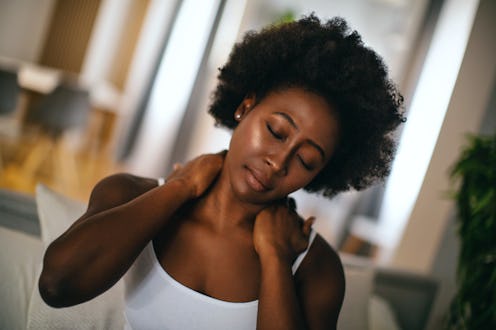Wellness
The Anmian Acupressure Point Is Like A Snooze Button On Your Head
It's legit.

Even if you complete your cozy evening routine — and gobble a few melatonin gummies, let’s be real — it doesn’t guarantee you’ll be able to fall asleep. Sometimes your brain clicks on or that late-afternoon coffee kicks in, and you end up lying awake for hours on end. In those moments, it can help to press a certain acupressure point behind your ears aptly named the “snooze button.”
Acupressure is one of the many modalities used in Traditional Chinese Medicine (TCM), says Dr. Nicole Glathe, DAOM, LAc, DiplOM, a doctor of Chinese Medicine, acupuncturist, and head of product and service innovation at wellness hub WTHN. The snooze button — also called the anmien, which translates to “peaceful sleep” — is one of them, and it’s a pressure point located behind each ear. All you have to do is massage the area for a few minutes, and you’ll supposedly be out like a light.
According to Glathe, this pressure point is helpful for anyone who has trouble falling asleep or staying asleep due to stress. It’s great to try once you get into bed or if you wake up in the middle of the night, she tells Bustle. Keep scrolling below for more info about the snooze button, why it works, and how to find the all-important pressure point.
How The Anmian Pressure Point Works
Acupressure taps into the body’s methods of promoting relaxation, wellness, and regulation, Glathe explains. “It uses points on the body, referred to as acupoints, which can be stimulated using pressure — called acupressure — or by inserting hair-thin needles, called acupuncture,” she tells Bustle.
Acupressure is the needle-free option, and it’s one you can easily do to yourself at home. “It usually requires repetition and consistency to achieve the therapeutic effect, but it can be done by anyone — anytime and anywhere,” she adds, including when you’re in bed.
While there are quite a few acupressure points that promote sleep, the snooze buttons located behind the ears are used to promote relaxation and calm the mind, explains Glathe, which are both necessary parts of falling asleep. “Studies have shown that when this point is used, the sleeping quality of patients with insomnia is improved,” she says.
On TikTok, acupuncturist @anew.acu posted about the snooze button to rave reviews. One of her commenters wrote, “I was skeptical but tried it last night. It worked like magic.” Another simply said, “Oh my goodness.” And then presumably fell asleep.
How To Find The “Snooze Button”
Here, Glathe explains how to find your snooze button:
- Get into bed and get comfy.
- Feel behind both earlobes for a hard, protruding bone.
- Find the peak of the rounded bone towards the bottom.
- Let your fingers fall backwards behind the bone towards your neck into a softer divot.
- That soft spot is the pressure point.
- Start to gently massage.
- Keep massaging in small circles while taking five or more deep breaths.
- Give yourself a few minutes to relax into sleep.
- If you’re still awake, repeat the cycle one to two more times.
Studies referenced:
Huo, ZJ. (2013). Effects of acupuncture with meridian acupoints and three Anmian acupoints on insomnia and related depression and anxiety state. Chin J Integr Med. doi: 10.1007/s11655-012-1240-6.
Lin, CH. (2021). An Association Rule Analysis of the Acupressure Effect on Sleep Quality. Evid Based Complement Alternat Med. doi: 10.1155/2021/1399258.
Waits, A. (2018). Acupressure effect on sleep quality: A systematic review and meta-analysis. Sleep Med Rev. 2018 Feb;37:24-34. doi: 10.1016/j.smrv.2016.12.004. Epub 2016 Dec 22. PMID: 28089414.
Source:
Dr. Nicole Glathe, DAOM, LAc, DiplOM, doctor of Chinese Medicine, acupuncturist, head of product and service innovation at wellness hub WTHN
This article was originally published on